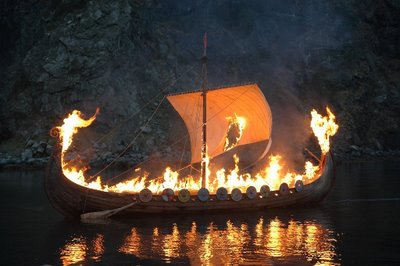Norse mythology was deeply intertwined with the daily lives of the Vikings.
Their gods not only represented natural or cosmic forces, but also directly influenced war, navigation, agriculture and prosperity.
Understanding which gods were most venerated allows us to discover how the Vikings sought protection, guidance, and balance in an uncertain and dangerous world.
Odin: the father of the gods

Odin was considered the supreme god, patron of wisdom, war and death.
Warriors worshipped him before battles, hoping to gain his favor and achieve victory and eternal honor.
Furthermore, Odin was the god of poetry and magic, traits that demonstrated that his influence was not limited only to combat, but also to strategy, intelligence, and Norse culture.
Amulets and offerings were common in his honor, and his symbol, the Valknut, appeared on inscriptions and funerary monuments.
Thor: strength and protection

Thor, god of thunder, was perhaps the most popular among Vikings of all social classes.
Protector of humans against giants and forces of chaos, his hammer Mjolnir became a symbol of power and defense.
Thor was worshipped by peasants, merchants, and warriors seeking safety in their homes and travels.
Festivals and ceremonies in her honor celebrated the power of nature and the importance of divine protection in daily life.
Freyja: love, fertility and magic

Freyja was the goddess of love, beauty, fertility and seiðr magic.
Their role was fundamental in the life of the Vikings, especially in agriculture, family and spiritual rituals.
Furthermore, Freyja received half of the warriors who fell in combat in her field, Fólkvangr, showing that her influence also encompassed war and the destiny of heroes.
Her cult was widespread among women and families seeking prosperity and protection.
Frey and Njord: prosperity and sea

Frey, brother of Freyja, was the god of fertility and abundance.
Vikings who depended on the land worshipped it to ensure good harvests and prosperity.
Njord, their father, was the god of the sea, navigation and maritime trade, vital elements for a society of explorers and merchants.
His cult ensured safe travel, good fishing, and wealth through trade routes from Scandinavia to the Islamic world.
Tyr, Balder and Hel: justice, purity and destiny

Tyr, god of war and justice, inspired respect for his courage and sacrifice, such as when he lost his hand while chaining the wolf Fenrir.
Balder, the god of light and purity, symbolized life, beauty, and inevitable destiny. His death became a central myth in Norse tradition.
Hel, goddess of the underworld, ruled over those who died naturally or ingloriously in battle. Although she was not actively worshipped, her presence influenced funerals and the understanding of death.

Faith and survival
The Vikings worshipped gods who could protect them, guide them, and ensure their well-being.
Odin, Thor, Freyja and Frey were the most important, while Tyr, Balder and Hel fulfilled complementary functions.
The worship of these gods reflected a balance between war and peace, life and death, strength and fertility.
Viking spirituality not only gave meaning to their battles and explorations, but also enabled them to face life with courage, wisdom, and hope for the destiny that awaited them in the afterlife.









